True Charm Conquers All
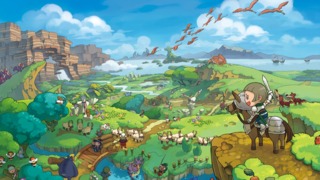
Titles that set out with the purpose of giving players a virtual life are nothing new. They are, after all, not only a consequence of the power games have to immerse their fans in fantastic worlds, but also of the increasing amount of content software can carry. Fantasy Life is, simultaneously, a lot alike and really different from most works that fall under that niche: the similarity lies in the fact that it loads itself with so much to do that full completion is hard to envision, but the distinction is the defined goals the game is quick to establish. This is a universe on which one can spend endless hours, but – at the same time – where there are clear objectives to pursue.
That blend is achieved smartly, for Fantasy Life brings together role-playing elements – the game's core – with a focus on collecting furniture and doing other seemingly mundane activities that is easily comparable to Nintendo's stellar line of Animal Crossing games. It works both ways, because those who are usually bothered by the lack of focus of open-ended titles will have a shiny finish line to chase, and anyone who loves the loose freedom of the genre will get a bundle of that independence along with a structured adventure to tackle.
It all begins when the main nameless character has to make a very important decision: select the life he wants to pursue. When he arrives in the castle to voice his choice, the infant-looking king expresses his concern over events that have been plaguing the land of Reveria. As it turns out, the sky seems to be falling apart, and its pieces – tellingly named Doomstones – are causing major damage and also mysteriously affecting the creatures of the areas on which they fall. Naturally, noticing the energy and enthusiasm of the soon-to-be hero, the king tasks the youngster with the investigation of those occurrences.
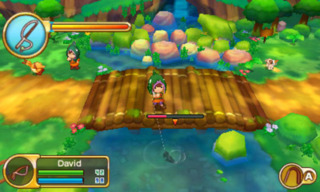
And that, right there, is the point when the game opens the way for its two facets: its RPG adventure, which is the main storyline; and its life system, which is what turns Fantasy Life into a unique product. Starting from that very early moment, gamers can take the wheel and decide whether they want to focus in advancing in their selected career, or go after the quests that make up the solving of the riddle behind the sinister stones. It is a very intense sense of freedom, and it makes everything seem like a huge explorable open-world that can be experienced in many different ways.
The game offers twelve career choices. It is indeed a large number, but – for practical purposes – they could be easily divided in three groups. Firstly, there are the lives that gravitate around combat: Paladin, a regular sword-yielding soldier; Hunter, a bow specialist; Wizard, a user of elemental magic; and Mercenary, a slow unit that deals a large amount of damage. Secondly, there are those that harvest resources from the land: Angler, Woodcutter, and Miner. And, finally, there are lives whose goal is to use resources and loot to craft new items: Blacksmith, Carpenter, Tailor, Alchemist, and Cook.
Thankfully, due to the total combat ineptitude that the harvesting and crafting classes posses, and smartly, since it gives players the chance to truly go through everything the game has to offer, it is possible to mutually belong to any number of lives. Inside each of those careers, players can level up in rank according to the class-specific tasks they are able to complete, which allows the use of new and more powerful weapons or tools, and the learning of new class-related techniques.
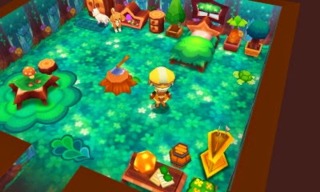
The option to freely switch between classes turns out to be brilliant in two ways. For starters, it supports the heavy collaboration between each skill. For example, a very rare piece of lumber found by a high-level woodcutter can be employed by a carpenter in the making of an epically mighty shield that will be used in battle by a master paladin; on the other hand, that piece of wood could simply be used in the crafting of a bed that will look just perfect on your newly acquired seaside hut. Fantasy Life fills players' hands with a multitude of choices, and it is up to them to have fun in whatever way they see fit.
The second direct effect of being able to play all of the roles is that it is possible to, while traveling through the wonderful land of Reveria, have up to fourteen lists of numerous quests of distinct natures: one for each of the twelve classes, one related to the main quest, and one consisting of requests made by NPCs. Players can pretty much freely choose what they want to do, where they want to go, and whether it is time to upgrade their interior decoration, climb up the ladder in a certain class, go after treasure to buy that fancy piece of real estate, or save the world.
It sounds overwhelming, it comes off as ridiculously impossible to manage, and it is numerically astounding. However, not only does Fantasy Life make it all seem like a relaxing pleasure, but those hundreds of quests also serve as the sweet excuse players will have to spend hundreds of hours in Reveria.
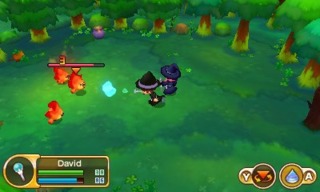
And that is precisely where Fantasy Life truly shines. Players will desperately look for a reason to put their adventure gear on and face the dangers of the world, and the game will give them about a few dozen pieces of motivation. That eager want for a purpose to explore Reveria is easily explained by one undeniable fact: few, maybe zero, games out there are as unbelievably charming as Fantasy Life.
The loveliness is so dense that it oozes from every single corner. It begins with the involving soundtrack, which was handled by the gifted Nobuo Uematsu, the man responsible for the tunes that drive the emotional weight of most Final Fantasy games into the stratosphere. His work here lives up to his credentials. Faced with a world that is far more light-hearted than what one usually finds on the Square-Enix flagship franchise, his music is able to convey both the whimsical and the slightly dramatic with perfection.
Then there is Reveria itself, which is as adorable as a virtual planet can be. From the outset, and without having to wait for the story to progress much, it is possible to go pretty much anywhere, and the sights to behold are many. This is a land that pairs up a traditional medieval kingdom, a port town with Caribbean motifs whose ruling is shared by aristocrats and pirates, and a desert land bursting with magicians, and it makes all those strange pieces fit together through its simple graphics that are sustained by a masterful art style. In between those places, players will explore everything from natural reserves, volcanoes, plains, floating islands, deserts, and countless caves.
All of those locations are filled to the brim with hordes of enemies whose design was carefully constructed, making them seem right at home in this borderline fairy-tale world. Although some are indeed threatening due to the absurdly high level they possess, almost none of them come off as dangerous or evil in their looks. They lean more towards goofy. And that light nature goes right along with one of the greatest things about Reveria: the fact that, despite the threat of the falling sky, this is a place with no real enemies. There is absolutely no one with a demeanor of cartoonish evil; these are all regular, yet incredibly amusing, people living in a fantastic world.
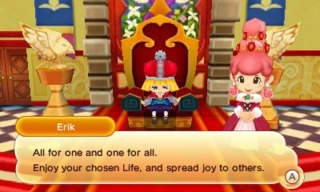
What truly lays down the bricks that make up this wonderful land are the dialogues that give heart to these characters. They can be truthfully touching (without ever coming close to cheesiness) and laugh-out-loud hilarious. And that quality is present literally everywhere; it is in the minor characters that take care of shops, in those who frequently ask players to do sidequests, in the main storyline participants, and in the numerous carefully developed people that are available to be recruited to the player's party when they set out for adventure.
Nowhere is that trait clearer than on the butterfly that serves as your main companion during the game. She is able to be warmly friendly, easily lovable, sharply sarcastic, truthfully helpful and brilliantly mocking all at the same time. It would be no exaggeration to dub her the greatest sidekick to ever grace a game.
For all of its qualities, there is one reality that holds Fantasy Life back from achieving everything its concept and charm could have allowed: this is a somewhat flawed game. Getting to the end of its storyline is so easy it demands almost no effort, and a large number of the quests involved in it are just a matter of heading to a certain location (which is almost always highlighted on the map) and talking to someone. This means that Fantasy Life is a game that is very heavy in text. Given the dialogues are invariably great, it is not an inherent issue, but it is a characteristic that might turn off some people.
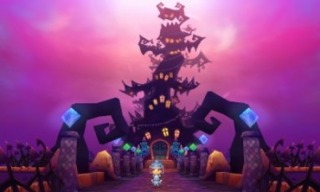
Additionally, it is disappointing to realize that, in a game whose core allure is the variety of professions to choose from, many of them are similar to a certain degree. The five crafting lives (tailor, carpenter, blacksmith, alchemist, and cook) all involve the same mini-game that is merely presented in a different skin depending on the item one wants to create. The same applies to the harvesting careers of mining and woodcutting, which offer the same commands and techniques, albeit with different goals; and the battling jobs, which present an equal shortcoming.
The various professions are also the source of a minor annoyance. In order to go up a rank in a certain occupation, players must validate their completed quests with the guild's master. However, in spite of the fact the main character can simultaneously be engaged in all 12 careers, only one of the licenses can be carried at a time. Therefore, to report completed tasks to a specific master, players must either be holding that job's license or else they will have to go back to the town's office, pick up the required document, and only then head to the guild's leader.
It is a silly limitation that makes no sense at all, because players can perform activities or do quests pertaining to any profession regardless of the license they are currently carrying (for example, a character holding a hunter license can mine at will as long as he has also been certified as a miner).
The game's greatest problem, however, lies in the structure of its quests. Fantasy Life has very clear inspirations in the universe of MMOs, which ends up translating into tasks that can have a heavy focus on sheer grinding. Although that is not true about the main quest, it is an unshakable fact that is attached to the job-specific goals and general sidequests. Although they are cleverly presented in different ways, most gravitate around going to a precise location and either killing a certain number of foes, searching for elusive item drops, gathering specific resources, and sometimes using what you have collected to build something through the crafting professions.
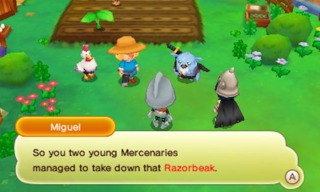
It is a never-ending, and somewhat repetitive, cycle of going out into the world and grinding your way to the finding of something special. It sounds shallow, and to a certain level it is pretty hollow, but the bottom line is that it all works. Somehow Fantasy Life escapes nearly unscathed through all of its major stumbles and minor issues to come out on the other side as this delightful game that can be awfully hard to put down simply due to the fact that you will want to spend more time in Reveria, and the game will happily oblige by throwing hundreds of quests onto the players laps.
Sure, the quests might be repetitive and involve a lot of grinding, but they are an excuse to go out there and explore some more and – maybe – even discover some interesting new place full of fun characters and creatures. How does Fantasy Life manage to muster such magic despite its problems? It all comes down to its overwhelming charm and the pure joy of getting a taste of what can be found in its world. It is irresistible, and at the same time a weird sort of guilty pleasure. In this case, true charm truly conquers all, even the most glaring flaws.


















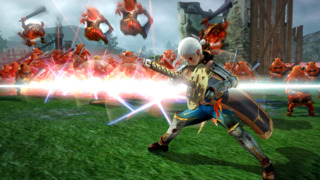


















Log in to comment